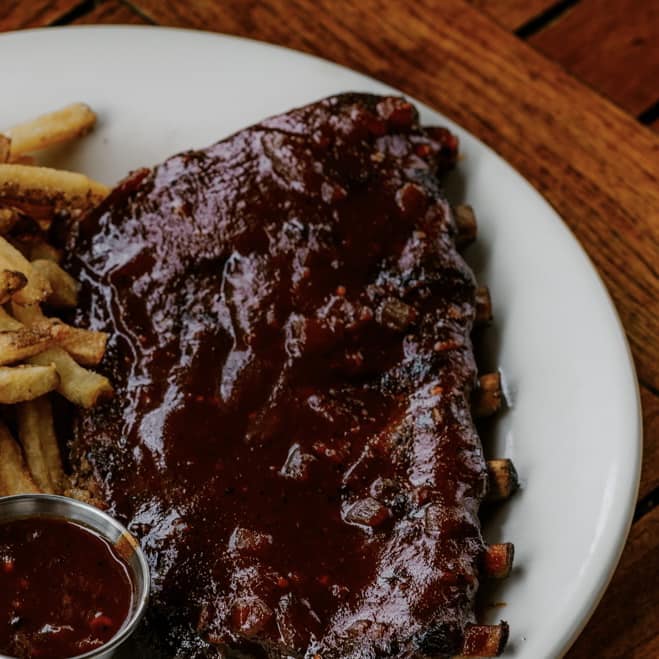
High quality pork, a bunch of spice, smoke, a plethora of patience
By Ari Weinzweig
It’s hard to believe that the Roadhouse opened it’s doors in 2003. One of the most important culinary components since we opened has quietly become one of the most popular dishes on the menu. We don’t really promote them all that prominently but we probably should; we sell a lot of ribs! And they’re really, really good! It’s amazing how many compliments we get on them. It is not uncommon to hear comments from first time guests like: “These are the best ribs I’ve ever had.” A couple years ago, one of our longtime regulars did a road trip across much of the Southern U.S. He’s a big rib guy so he made a point of stopping at most of the famous places. When he came back he pulled me aside to tell me that he’d tried ribs from a couple dozen high end spots, but he didn’t find anything to match what he’d been eating here for years. I’m not competitive enough to try to class them in some sort of ranking: I’ll just say that if you like eating ribs, treat yourself to a rack or two at the Roadhouse. It’s pretty clear to me, from what people have told me, that they evoke awe for the many who do.
About the pork.
A big part of what makes the ribs so special is the raw material—it’s hard to make great ribs if you don’t start with sustainably raised pork. We begin with St. Louis-cut ribs (the meatier ribs cut from the belly of the hog after the pork belly is removed) from Niman Ranch farmers. Check out the Niman farmer protocols to get a good idea of why the quality is so high. In a nutshell, it’s a reliance on old, more flavorful, lower yield breeds; pastured hog raising; better marbling in the meat; no antibiotics; and bringing more mature animals to market.
How we make our ribs.
To make the ribs, we season the fresh pork with sea salt, Tellicherry black pepper, cumin, and coriander and then put them out on the pit over a low temperature oak wood fire for about three hours. The pit work is, of course, a craft that has to be adjusted daily depending on outside temperature, humidity, wind, etc. The Roadhouse crew is cooking in everything from a 98°F day in early July to a 9°F day in late January. When they come off the pit, the ribs are sealed into heavy roasting pans with a bit of organic Quebec cider vinegar, then put into the oven to braise for a second three-hour period. Finally, they’re taken from the oven—without breaking the foil seal—and then allowed to steam for another three hours. The result is some seriously tender, softly smoky, nicely spicy, very flavorful, and for many I’ve come to understand, awe-inspiring pork. This is absolutely artisan work of the highest order.
How we serve our ribs!
To serve the ribs, we heat ‘em up on the grill, dress ‘em with some of the Roadhouse’s Red Rage Barbecue Sauce—tomato-based with plenty of Wolverine Pub Ale, Marash and Urfa red pepper flakes from Turkey, Tellicherry black pepper, ground coffee (Roadhouse Joe of course), Muscovado brown sugar, and some cayenne to spice it up a bit. The ribs are very good, too, with the South Carolina Mustard barbecue sauce. You can also order the ribs to pick up at the Roadshow hot to take home (maybe give them a bit of heat before you eat—I like mine hot!) Or pick up a few racks cold and reheat them fully in your oven. If you bring them home sauce-less you can also do them as dry ribs, in which case the sauce should be strictly on the side, for dipping only. I’m also a big fan of pulling the meat off the bone and making a really kick-butt rib sandwich—add some of the Roadhouse’s mustard coleslaw, some sauce, and pile it on a brioche roll from the Bakehouse. Terrific!
